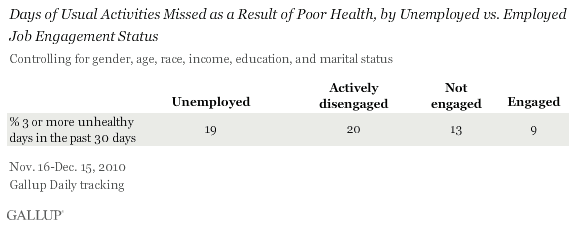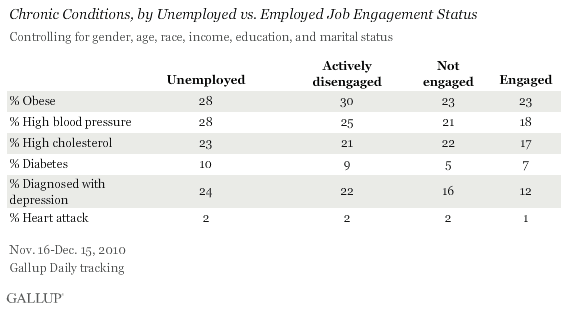WASHINGTON, D.C. -- American workers who are emotionally disconnected from their work and workplace are about as likely as the unemployed -- but far less likely than those who are engaged in their jobs -- to report they are in excellent health. Nearly 2 in 10 of these "actively disengaged" workers rate their overall health as "excellent," similar to the 22% of the unemployed, but significantly fewer than the 31% of engaged workers.

These findings are from a special Gallup Daily tracking series conducted in November and December 2010 to explore in greater depth American workers' engagement levels. Gallup's employee engagement index is based on worker responses to 12 workplace elements with proven linkages to performance outcomes, including productivity, customer service, quality, retention, safety, and profit.
Engaged employees are involved in and enthusiastic about their work. Those who are not engaged are satisfied with but are not emotionally connected to their workplaces and are less likely to put in discretionary effort. The actively disengaged workers are emotionally disconnected from their work and workplace and jeopardize the performance of their teams.
Actively Disengaged and Unemployed Report More Unhealthy Days Than Engaged Workers
At least one in in five unemployed respondents and actively disengaged workers report that poor health kept them from their usual activities on 3 or more days out of the past 30. Engaged workers are less than half as likely to report having 3 or more unhealthy days in the past 30.

Obesity and Chronic Disease Rates High Among Actively Disengaged and Unemployed
Actively disengaged and unemployed Americans' higher percentages of unhealthy days are likely tied to their higher rates of chronic disease and obesity. The Gallup-Healthways Well-Being Index calculates obesity levels based on respondents' self-reported height and weight. Body Mass Index scores of 30 or higher are considered obese.
Of those Gallup surveyed, 30% of actively disengaged workers and 28% of unemployed Americans are obese. This is higher than the national average and much higher than the 23% of engaged workers who are obese.
Actively disengaged employees are also as likely as the jobless to report having been diagnosed with several chronic illnesses over the course of their lifetimes. High blood pressure, high cholesterol, and diabetes are all about as prevalent among the actively disengaged workforce as they are among the unemployed. Slightly more than 2 in 10 in both groups also report having been diagnosed with depression.
Engaged workers are in the best health, reporting rates of chronic illnesses that are much lower than the actively disengaged and unemployed populations.

Implications
Gallup research has found that how employees are managed can significantly influence employee engagement and disengagement, which in turn influences an organization's bottom line. This analysis suggests there also could be health implications related to workplace engagement. Workplaces that create environments that disengage employees might be creating health risks that are as troubling as those the unemployed face.
This analysis, however, cannot definitively determine the direction of the causal relationship between engagement and health. It is possible that workers who are unhealthy become disengaged or unemployed, or that there are additional variables that could explain these relationships. Nevertheless, the results do control for gender, age, income, education, race, and marital status differences. Additionally, prior longitudinal research published in JAMA and the Archives of Internal Medicine suggests that perceptions of working conditions explain risk in future coronary heart disease among employees.
Regardless, actively disengaged workers and the unemployed are in significantly worse health than Americans who are engaged in their jobs, according to Gallup data. The high rates of obesity and chronic illnesses these groups report could have a major effect on their long-term health and on U.S. healthcare costs. While addressing the health problems of the unemployed may be difficult, business leaders could play a major role in improving the workplace environment and potentially the health and well-being of actively disengaged workers.
About the Gallup-Healthways Well-Being Index
The Gallup-Healthways Well-Being Index tracks U.S. well-being and provides best-in-class solutions for a healthier world. To learn more, please visit well-beingindex.com.
About Gallup's Employee Engagement Index
Gallup's employee engagement index is based on decades of research studying which workplace elements matter most in driving performance outcomes across organizations throughout the world. Gallup researchers identified 12 elements that are summarized into 12 survey items. A composite of employee responses to the 12 items is used to formulate the engagement index groupings: engaged, not engaged, and actively disengaged.
About Gallup's Unemployment Index
Gallup's unemployment index categorizes respondents as "unemployed" if they are not employed, even for one hour a week, but are available and looking for work.
Survey Methods
Results are based on telephone interviews conducted as part of the Gallup Daily tracking survey Nov. 16-Dec. 15, 2010, with a random sample of 3,421 adults, aged 18 and older, living in all 50 U.S. states and the District of Columbia, selected using random-digit-dial sampling. The survey includes 1,266 unemployed, 400 actively disengaged, 1,116 not engaged, and 594 engaged respondents.
Maximum expected error ranges for subgroups vary according to size, ranging from ±2.8 percentage points for the largest group to ±4.9 percentage points for the smallest group.
Interviews are conducted with respondents on landline telephones and cellular phones, with interviews conducted in Spanish for respondents who are primarily Spanish-speaking. Each daily sample includes a minimum quota of 200 cell phone respondents and 800 landline respondents, with additional minimum quotas among landline respondents for gender within region. Landline respondents are chosen at random within each household on the basis of which member had the most recent birthday.
Samples are weighted by gender, age, race, Hispanic ethnicity, education, region, adults in the household, cell phone-only status, cell phone-mostly status, and phone lines. Demographic weighting targets are based on the March 2010 Current Population Survey figures for the aged 18 and older non-institutionalized population living in U.S. telephone households. All reported margins of sampling error include the computed design effects for weighting and sample design.
In addition to sampling error, question wording and practical difficulties in conducting surveys can introduce error or bias into the findings of public opinion polls.
For more details on Gallup's polling methodology, visit www.gallup.com.

